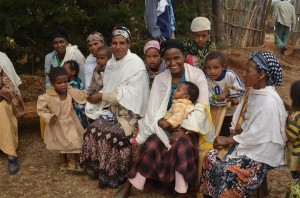Empowering Communities in Ethiopia
Mar 22nd, 2013 | By admin | Category: Family PlanningBy Suzanne York, www.howmany.org
There is nothing like going out into the field and seeing first-hand what is happening on the ground to validate your work and experience. That’s when you learn how projects, ideas and initiatives can really work (or in some cases, not work).
Here in Ethiopia, after the recent conference of the Population, Health and Environment (PHE) Consortium, a small group of participants spent the day traveling to the Guraghe Zone and the Guraghe Peoples Self-Help Development Organization (GPSDO) site, about 200 kilometers west of the capital city of Addis Ababa.
GPSDO is a member of the PHE Ethiopia Consortium that has implemented this holistic, integrated approach in local villages as a way to bring them healthcare, education, family planning, and environmental/natural resource management.
The Guraghe are an ethnic group in Ethiopia. The main issues facing the communities, according to the GPSDO, are the following: 1) high population pressure (due to large family size and few family planning services); 2) health problems (especially high maternal mortality); and 3) environmental problems (namely soil erosion). Other problems include female illiteracy, gender inequality, and unemployment.
The promising attribute of PHE projects is that it is an integrated approach dealing with multiple, critical issues. In doing so, one sector is not ignored to the detriment of another. If only environmental challenges are dealt with but not the need for family planning services and sustainable livelihoods, the chance of success are much lower. When issues and linked and addressed jointly, the results are much better.
In Guraghe, our group visited just one kabela, or administrative district, with a population of just over 4,400 people. The GPSDO stated there was a 97% contraceptive prevalence rate amongst sexually active people in this kabela.
To reach this incredible rate, the community trained local voluntary health workers, in conjunction with government sponsored health extension workers who provide education on reproductive health, along with products such as injectables and implants. The community also worked with religious leaders and elders to overcome resistance, through lengthy discussions, workshops, and trainings.
Environmental and conservation measures included the introduction of energy saving cookstoves, the planting of native seedlings (such as acacia trees) to combat soil erosion, and building flood diversion canals.
This is just a brief taste of the successful outcomes created when population growth, family planning/women’s health, sustainable livelihoods, and environmental protection are integrated.

